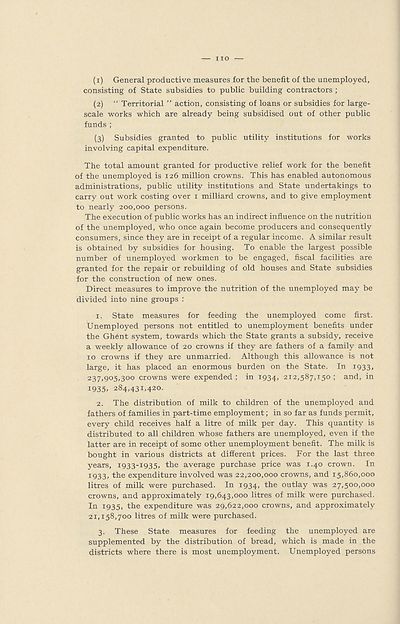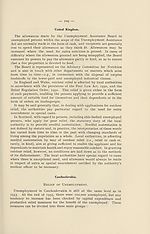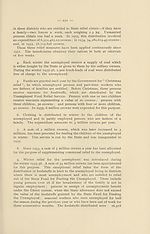Download files
Complete book:
Individual page:
Thumbnail gallery: Grid view | List view

no
(1) General productive measures for the benefit of the unemployed,
consisting of State subsidies to public building contractors ;
(2) “ Territorial ” action, consisting of loans or subsidies for large-
scale works which are already being subsidised out of other public
funds ;
(3) Subsidies granted to public utility institutions for works
involving capital expenditure.
The total amount granted for productive relief work for the benefit
of the unemployed is 126 million crowns. This has enabled autonomous
administrations, public utility institutions and State undertakings to
carry out work costing over 1 milliard crowns, and to give employment
to nearly 200,000 persons.
The execution of public works has an indirect influence on the nutrition
of the unemployed, who once again become producers and consequently
consumers, since they are in receipt of a regular income. A similar result
is obtained by subsidies for housing. To enable the largest possible
number of unemployed workmen to be engaged, fiscal facilities are
granted for the repair or rebuilding of old houses and State subsidies
for the construction of new ones.
Direct measures to improve the nutrition of the unemployed may be
divided into nine groups :
1. State measures for feeding the unemployed come first.
Unemployed persons not entitled to unemployment benefits under
the Ghent system, towards which the State grants a subsidy, receive
a weekly allowance of 20 crowns if they are fathers of a family and
10 crowns if they are unmarried. Although this allowance is not
large, it has placed an enormous burden on the State. In 1933,
237,9o5,3o° crowns were expended ; in 1934, 212,587,150 ; and, in
1935. 284,431,420.
2. The distribution of milk to children of the unemployed and
fathers of families in part-time employment; in so far as funds permit,
every child receives half a litre of milk per day. This quantity is
distributed to all children whose fathers are unemployed, even if the
latter are in receipt of some other unemployment benefit. The milk is
bought in various districts at different prices. For the last three
years, 1933-1935, the average purchase price was 1.40 crown. In
1933, the expenditure involved was 22,200,000 crowns, and 15,860,000
litres of milk were purchased. In 1934, the outlay was 27,500,000
crowns, and approximately 19,643,000 litres of milk were purchased.
In 1935, the expenditure was 29,622,000 crowns, and approximately
21,158,700 litres of milk were purchased.
3. These State measures for feeding the unemployed are
supplemented by the distribution of bread, which is made in the
districts where there is most unemployment. Unemployed persons
(1) General productive measures for the benefit of the unemployed,
consisting of State subsidies to public building contractors ;
(2) “ Territorial ” action, consisting of loans or subsidies for large-
scale works which are already being subsidised out of other public
funds ;
(3) Subsidies granted to public utility institutions for works
involving capital expenditure.
The total amount granted for productive relief work for the benefit
of the unemployed is 126 million crowns. This has enabled autonomous
administrations, public utility institutions and State undertakings to
carry out work costing over 1 milliard crowns, and to give employment
to nearly 200,000 persons.
The execution of public works has an indirect influence on the nutrition
of the unemployed, who once again become producers and consequently
consumers, since they are in receipt of a regular income. A similar result
is obtained by subsidies for housing. To enable the largest possible
number of unemployed workmen to be engaged, fiscal facilities are
granted for the repair or rebuilding of old houses and State subsidies
for the construction of new ones.
Direct measures to improve the nutrition of the unemployed may be
divided into nine groups :
1. State measures for feeding the unemployed come first.
Unemployed persons not entitled to unemployment benefits under
the Ghent system, towards which the State grants a subsidy, receive
a weekly allowance of 20 crowns if they are fathers of a family and
10 crowns if they are unmarried. Although this allowance is not
large, it has placed an enormous burden on the State. In 1933,
237,9o5,3o° crowns were expended ; in 1934, 212,587,150 ; and, in
1935. 284,431,420.
2. The distribution of milk to children of the unemployed and
fathers of families in part-time employment; in so far as funds permit,
every child receives half a litre of milk per day. This quantity is
distributed to all children whose fathers are unemployed, even if the
latter are in receipt of some other unemployment benefit. The milk is
bought in various districts at different prices. For the last three
years, 1933-1935, the average purchase price was 1.40 crown. In
1933, the expenditure involved was 22,200,000 crowns, and 15,860,000
litres of milk were purchased. In 1934, the outlay was 27,500,000
crowns, and approximately 19,643,000 litres of milk were purchased.
In 1935, the expenditure was 29,622,000 crowns, and approximately
21,158,700 litres of milk were purchased.
3. These State measures for feeding the unemployed are
supplemented by the distribution of bread, which is made in the
districts where there is most unemployment. Unemployed persons
Set display mode to:
![]() Universal Viewer |
Universal Viewer | ![]() Mirador |
Large image | Transcription
Mirador |
Large image | Transcription
Images and transcriptions on this page, including medium image downloads, may be used under the Creative Commons Attribution 4.0 International Licence unless otherwise stated. ![]()
| League of Nations > Economic and financial section > Problem of nutrition > (112) |
|---|
| Permanent URL | https://digital.nls.uk/190925218 |
|---|
| Shelfmark | LN.II |
|---|
| Description | Over 1,200 documents from the non-political organs of the League of Nations that dealt with health, disarmament, economic and financial matters for the duration of the League (1919-1945). Also online are statistical bulletins, essential facts, and an overview of the League by the first Secretary General, Sir Eric Drummond. These items are part of the Official Publications collection at the National Library of Scotland. |
|---|---|
| Additional NLS resources: |
|

